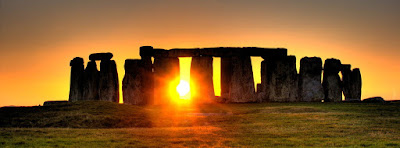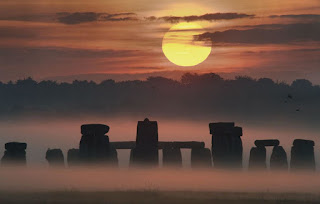Summer Solstice: Legends and Lore about this Magical Day
Mackenzie Wright
Summer Solstice marks the longest day and shortest night of the year. It's the point at which the days have been consistently growing longer for half a year, and will now begin growing shorter again for the rest of the year. In the Northern Hemisphere, it occurs on or about June 21st; in the Southern Hemisphere, it occurs in December.
 |
| Putnam at Stonehenge |
There are a lot of legends and lore about this day from history that can make for fun stories if you find yourself at a Midsummer bonfire or beach party.
Midsummer Night's Dream
If you're familiar with the Shakespeare play, you know that the bard wrote about the mischievous fairies coming out to play their tricks on human beings on this night. There is a reason that Shakespeare used this date for this story. In fairy legends and folklore, this is supposed to be a night in which the 'veil' between our world and the world of fairy and nature spirits are thin.
There are a lot of legends and lore about this day from history that can make for fun stories if you find yourself at a Midsummer bonfire or beach party.
It's said that if you hope to catch a glimpse of a fairy, this is the best night. You would first have to find a fairy circle-- a circle of stones in which fairies gather. Or, you'd need to create a place that would attract fairies. Ideally, this should be a natural area of your yard.
Leaving out offerings such as shiny things to play with (crystals, glittery balls) as well as food offerings like honey, milk and fruit will also be inviting to these spirits. One thing you should know, though-- fairies are thought to be very tricky, and have even been known to kidnap humans.
Also be wary of other little people, or ‘hidden folk’ on this night; along with fairies, you might run into trolls or evil nature spirits in the midst of this night. I can’t vouch for any of this, but if you do decide to wait up for them, you’ve been warned! Stay safe!
Stonehenge
The ancient Celts were said to celebrate the solstices at the standing stones sites, like
Magical Herbs
The Summer Solstices has long been associated with magic. In ancient times people would harvest wild herbs, plants and flowers at sunrise. This time was seen as capturing the magic of the various plants. People collected fern seeds because they thought it made them invisible. The made wreaths and garland of herbs to hang on the home and front door in order to ward off evil. Even the dew was seen as magical on the Summer Solstice. It was a common practice in
If you really want to take advantage of that dew, you can roll around in it naked. Though it may bring you good physical health, watch out for your neighbors. If they catch you, they’ll surely question your mental health.
The Sun festivals of ancient Ireland
But the advice for anyone seeking connection to the Celtic Gods is to avoid the current catholic calendar of the so-called civilised world to time your ceremony. Pagans and Druids on a Celtic Path use Natural Time as their ancestors did – this means working with the alignments of the oldest temples to the four bright stars in the belt of the Zodiac. The Solstices and Equinoxes do not line up with particular Stars, they are turning points of the day / night balance such as when the Sun’s energy enters the ancient temple at Brú na Boinne (Newgrange) energising the God Dagda after the longest night of the year. The history and correct timing methods are shared below for those who wish to walk a Celtic Path.
But the advice for anyone seeking connection to the Celtic Gods is to avoid the current catholic calendar of the so-called civilised world to time your ceremony. Pagans and Druids on a Celtic Path use Natural Time as their ancestors did – this means working with the alignments of the oldest temples to the four bright stars in the belt of the Zodiac. The Solstices and Equinoxes do not line up with particular Stars, they are turning points of the day / night balance such as when the Sun’s energy enters the ancient temple at Brú na Boinne (Newgrange) energising the God Dagda after the longest night of the year. The history and correct timing methods are shared below for those who wish to walk a Celtic Path.
Celtic Druid’s Summer Sun Standing
Solstice is from the Latin and is made up from two words given roughly as: sol = sun and stice = stopped. Celtic Druí do not believe that the Sun stops so we use the old Irish word “Tairisem” which means standing still. In summer this Sun Standing happens in the month of June around the 20th, 21st or 22nd when we honour Éatain Eachraidhe, the White Mare Goddess. This is the highest point of the solar year when the Sun reaches it maximum height in the Sky. The Sun is at its highest at noon and shadows are at their shortest. There are almost 20 hours of daylight and only four hours of darkness if you are in
This is not a specifically Gaelic holiday and many Pagan cultures celebrate this time with many festivals known by a range of names -
 |
| Putnam at Hopi Prophecy Stone |
Etain, White Mare Celtic Goddess, Crom agus Corra
In
This longest day is sacred to the White Mare Goddess, who was known in
We also watch the Sun rise from Tallaght Hill as the sun aligns with Lambay Volcano, the Pond called Linn Oir and then to the Cairn on the Hill of the Fair Gods. Much is written about this alignment in this website - words cannot describe the thrill of being at a complex of sacred sites that were laid out to work with the energies on this specific day.
We also hold Pilgrimage to
Litha Legends and Lore
Myths and Mysteries of the Midsummer Solstice
In England , rural villagers built a big bonfire on Midsummer's Eve. This was called "setting the watch," and it was known that the fire would keep evil spirits out of the town. Some farmers would light a fire on their land, and people would wander about, holding torches and lanterns, from one bonfire to another. If you jumped over a bonfire -- presumably without lighting your pants on fire -- you were guaranteed to have good luck for the coming year.
After your Litha fire has burned out and the ashes gone cold, use them to make a protective amulet. You can do this by carrying them in a small pouch, or kneading them into some soft clay and forming a talisman. In some traditions of Wicca, it is believed that the Midsummer ashes will protect you from misfortune. You can also sow the ashes from your bonfire into your garden, and your crops will be bountiful for the rest of the summer growing season.
It is believed in parts of England that if you stay up all night on Midsummer's Eve, sitting in the middle of a stone circle, you will see the Fae. But be careful - carry a bit of rue in your pocket to keep them from harassing you, or turn your jacket inside out to confuse them. If you have to escape the Fae, follow a ley line, and it will lead you to safety.
Residents of some areas of Ireland say that if you have something you wish to happen, you "give it to the pebble." Carry a stone in your hand as you circle the Litha bonfire, and whisper your request to the stone -- "heal my mother" or "help me be more courageous", for example. After your third turn around the fire, toss the stone into the flames.
Astrologically, the sun is entering Cancer, which is a water sign. Midsummer is not only a time of fire magic, but of water as well. Now is a good time to work magic involving sacred streams and holy wells. If you visit one, be sure to go just before sunrise on Litha, and approach the water from the east, with the rising sun. Circle the well or spring three times, walking deosil, and then make an offering of silver coins or pins.
Sunwheels were used to celebrate Midsummer in some early Pagan cultures. A wheel -- or sometimes a really big ball of straw -- was lit on fire and rolled down a hill into a river. The burned remnants were taken to the local temple and put on display. In Wales , it was believed that if the fire went out before the wheel hit the water, a good crop was guaranteed for the season.
In Egypt , the Midsummer season was associated with the flooding of the Nile River South America , paper boats are filled with flowers, and then set on fire. They are then sailed down the river, carrying prayers to the gods. In some traditions of modern Paganism, you can get rid of problems by writing them on a piece of paper and dropping them into a moving body of water on Litha.
William Shakespeare associated Midsummer with witchcraft in at least three of his plays. A Midsummer Night's Dream, Macbeth, and The Tempest all contain references to magic on the night of the summer solstice.
SCOTTISH CUSTOMS AND HOLIDAYS
A Midsummer CelebrationSummer Solstice - Litha
"The young maid stole through the cottage door,
And blushed as she sought the Plant of pow'r;--
Thou silver glow-worm, O lend me thy light,
I must gather the mystic
The wonderful herb, whose leaf will decide
If the coming year shall make me a bride."
In addition to the four great festivals of the Pagan Celtic year, there are four lesser holidays as well: the two solstices, and the two equinoxes. In folklore, these are referred to as the four 'quarter-days' of the year, and modern Witches call them the four 'Lesser Sabbats', or the four 'Low Holidays'. The Summer Solstice is one of them.
Technically, a solstice is an astronomical point and, due to the procession to the equinox, the date may vary by a few days depending on the year. The summer solstice occurs when the sun reaches the Tropic of Cancer, and we experience the longest day and the shortest night of the year. Astrologers know this as the date on which the sun enters the sign of Cancer.
However, since most European peasants were not accomplished at reading an ephemeris or did not live close enough to Salisbury Plain to trot over to
Again, it must be remembered that the Celts reckoned their days from sundown to sundown, so the June 24th festivities actually begin on the previous sundown (our June 23rd). This was Shakespeare's Midsummer Night's Eve. Which brings up another point: our modern calendars are quite misguided in suggesting that 'summer begins' on the solstice. According to the old folk calendar, summer BEGINS on May Day and ends on Lammas (August 1st), with the summer solstice, midway between the two, marking MID-summer. This makes more logical sense than suggesting that summer begins on the day when the sun's power begins to wane and the days grow shorter.
Although our Pagan ancestors probably preferred June 24th (and indeed most European folk festivals today use this date), the sensibility of modern Witches seems to prefer the actual solstice point, beginning the celebration on its eve, or the sunset immediately preceding the solstice point. Again, it gives modern Pagans a range of dates to choose from with, hopefully, a weekend embedded in it.
Just as the Pagan mid-winter celebration of Yule was adopted by Christians as Christmas (December 25th), so too the Pagan mid-summer celebration was adopted by them as the feast of John the Baptist (June 24th). Occurring 180 degrees apart on the wheel of the year, the mid-winter celebration commemorates the birth of Jesus, while the mid-summer celebration commemorates the birth of John, the prophet who was born six months before Jesus in order to announce his arrival.
Although modern Witches often refer to the holiday by the rather generic name of Midsummer's Eve, it is more probable that our Pagan ancestors of a few hundred years ago actually used the Christian name for the holiday, St. John's Eve. This is evident from the wealth of folklore that surrounds the summer solstice (i.e. that it is a night especially sacred to the faerie folk) but which is inevitably ascribed to 'St. John's Eve', with no mention of the sun's position. It could also be argued that a Coven's claim to antiquity might be judged by what name it gives the holidays. (Incidentally, the name 'Litha' for the holiday is a modern usage, possibly based on a Saxon word that means the opposite of Yule. Still, there is little historical justification for its use in this context.) But weren't our Pagan ancestors offended by the use of the name of a Christian saint for a pre-Christian holiday?
Well, to begin with, their theological sensibilities may not have been as finely honed as our own. But secondly and more importantly,
In
Customs surrounding St. John's Eve are many and varied. At the very least, most young folk plan to stay up throughout the whole of this shortest night. Certain courageous souls might spend the night keeping watch in the center of a circle of standing stones. To do so would certainly result in either death, madness, or (hopefully) the power of inspiration to become a great poet or bard. (This is, by the way, identical to certain incidents in the first branch of the 'Mabinogion'.) This was also the night when the serpents of the island would roll themselves into a hissing, writhing ball in order to engender the 'glain', also called the 'serpent's egg', 'snake stone', or 'Druid's egg'. Anyone in possession of this hard glass bubble would wield incredible magical powers. Even Merlyn himself (accompanied by his black dog) went in search of it, according to one ancient Welsh story.
Snakes were not the only creatures active on Midsummer's Eve. According to British faery lore, this night was second only to Halloween for its importance to the wee folk, who especially enjoyed a ridling on such a fine summer's night. In order to see them, you had only to gather fern seed at the stroke of midnight and rub it onto your eyelids. But be sure to carry a little bit of rue in your pocket, or you might well be 'pixie-led'. Or, failing the rue, you might simply turn your jacket inside-out, which should keep you from harm's way. But if even this fails, you must seek out one of the 'ley lines', the old straight tracks, and stay upon it to your destination. This will keep you safe from any malevolent power, as will crossing a stream of 'living' (running) water. Other customs included decking the house (especially over the front door) with birch, fennel,
"And the glow-worm came With its silvery flame, And sparkled and shone Through the night of
There are also many mythical associations with the summer solstice, not the least of which concerns the seasonal life of the God of the sun. Inasmuch as I believe that I have recently discovered certain associations and correspondences not hitherto realized, I have elected to treat this subject in some depth in another essay. Suffice it to say here, that I disagree with the generally accepted idea that the Sun-God meets his death at the summer solstice. I believe there is good reason to see the Sun-God at his zenith -- his peak of power -- on this day, and that his death at the hands of his rival would not occur for another quarter of a year. Material drawn from the Welsh mythos seems to support this thesis. In Irish mythology, Midsummer is the occasion of the first battle between the Fir Bolgs and the Tuatha De Danaan.
Altogether, Midsummer is a favorite holiday for many Witches in that it is so hospitable to outdoor celebrations. The warm summer night seems to invite it. And if the celebrants are not in fact skyclad, then you may be fairly certain that the long ritual robes of winter have yielded place to short, tunic-style apparel. As with the longer gowns, tradition dictates that one should wear nothing underneath -- the next best thing to skyclad, to be sure. (Incidentally, now you know the REAL answer to the old Scottish joke, 'What is worn underneath the kilt?')
The two chief icons of the holiday are the spear (symbol of the Sun-God in his glory) and the summer cauldron (symbol of the Goddess in her bounty). The precise meaning of these two symbols, which I believe I have recently discovered, will be explored in the essay on the death of Llew. But it is interesting to note here that modern Witches often use these same symbols in the Midsummer rituals. And one occasionally hears the alternative consecration formula, 'As the spear is to the male, so the cauldron is to the female...' With these mythic associations, it is no wonder that Midsummer is such a joyous and magical occasion!
.



























No comments:
Post a Comment